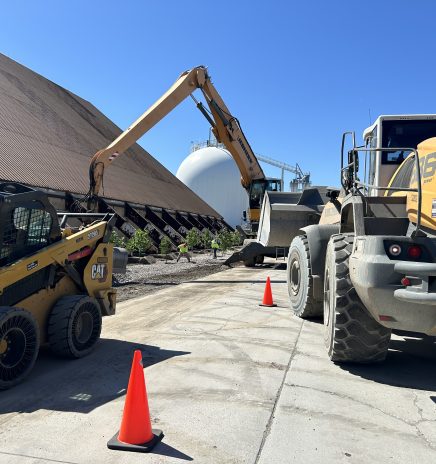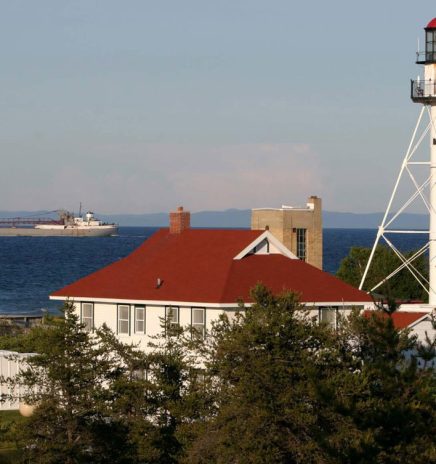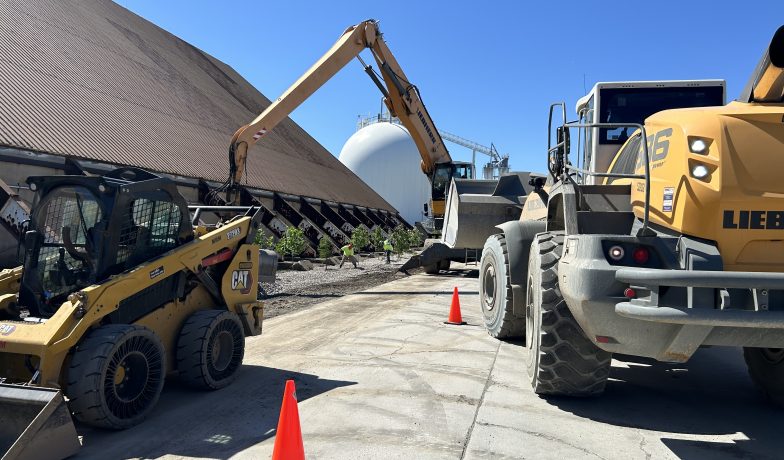Great Lakes States Receive USDA Forest Service Funding
These projects in the Great Lakes basin improve the quality of water flowing into the Great Lakes, the world’s largest surface freshwater system and the source of drinking water for more than 30 million people. The Great Lakes are critical for local economies, wildlife habitat, tourism, recreation and human health. Projects that plant trees, remove invasive species and stabilize streambanks in the watershed boost all these benefits from the Great Lakes.
As a result of the Forest Service’s GLRI grant program, since 2010, over 1 million trees have been planted on nonfederal lands, intercepting an estimated 18.5 million gallons of stormwater runoff per year and contributing to the restoration of an estimated 19,300 acres of land.

Some of the expected outcomes of this year’s projects include:
- Planting 107,620 trees, which will provide multiple benefits including reforestation of sites impacted by forest insects and disease and intercepting stormwater to reduce runoff that can cause flooding and pollute waterbodies.
- Mitigating forest insect and disease impacts with over 3,000 acres of reforestation and protective treatments.
- Supporting local partnerships to treat 1,790 acres for nonnative invasive plants and survey 111,130 acres for new infestations.
Wildlife Habitat Council (WHC) was awarded a Great Lakes Restoration Initiative grant to restore Calumet River shoreline. WHC worked with the Chicago Park District, Chicago Bureau of Forestry, Illinois Port District, U.S. Forest Service and the office of Alderwoman Susan Sadlowski Garza. On May 31, WHC, Midwest Marine, Ozinga and Middle River participated in a tree planting event at the South Chicago Terminal.
Funded Projects
This year’s funded organizations, project descriptions and federal funding amounts are listed below. For this round of funding, no match was required.
Illinois
- Student Conservation Association, $298,984.28: Calumet Urban Forestry Crew
- The Nature Conservancy, $100,000.00: Trees and Training for a Healthier South Side, Part 3
- Openlands, $300,000.00: Trees and Equity in the Lake Michigan Watershed: A Stormwater Reduction Partnership
- The Morton Arboretum, $300,000.00: Increasing Urban Forestry Advocacy and Canopy Through Community Stewardship and Maintenance
Indiana
- Northwestern Indiana Regional Planning Commission (NIRPC), $300,000.00: CommuniTree Pass Through Tree Grants
Michigan
- Ottawa Conservation District, $200,000.00: Addressing Hemlock Woolly Adelgid in West Michigan
- Chippewa Luce Mackinac Conservation District, $227,108.00: St. Mary’s River Stormwater Reduction Initiative
- Van Buren Conservation District, $300,000.00: Connecting Lake Associations with Their Upstream Watersheds in Southwest Michigan
- Oceana Conservation District, $200,000.00: Creating the Oceana Coastal Conservation Corridor
- ReLeaf Michigan Inc., $266,402.00: A Community-based Approach to Improve Water Quality in the River Raisin Watershed Through Assessment, Education, Engagement, and Tree Planting
- The Greening of Detroit, $197,677.00: Tree Planting in Detroit to Mitigate Impacts of Emerald Ash Borer
- The Greening of Detroit, $299,922.00: Reducing Stormwater Runoff in Eastside Detroit Neighborhoods through Reforestation
- Grand Valley Metro Council, $257,319.92: Branching Out: Planting Trees to Reduce Runoff in the Lower Grand River Watershed
- Dickinson Conservation District, $100,000.00: Wild Rivers ISC – Addressing Primary Invasive Species Pathways Through Multi-County Collaboration
- Mason-Lake Conservation District, $56,253.55: Promoting Native Plants for Urban Landscaping Increasing Recognition of Human Impacts on Ecology
- Van Buren Conservation District (fiduciary), $91,146.00: Consistent and Effective Invasive Plant Control Throughout the Jones Conservation Corridor
- Chippewa Luce Mackinac Conservation District, $83,000.00: Partnering Against Wild Parsnip
- International Wildlife Refuge Alliance, $99,924.00: Maintaining Quality Coastal Wetlands Restored Over the Past Decade in Detroit River-Western Lake Erie Cooperative Weed Management Area
- Iron Baraga Conservation District, $80,000.00: WePIC CWMA: Collaborative Control and Prevention of Invasive Species
- Antrim Conservation District (DBA CAKE CISMA), $100,000.00: Expand CAKE CISMA Capacity to Better Serve Rural Communities
Minnesota
- Community Action Duluth, $199,898.00: Restoration in the Lake Superior Watershed
- The Nature Conservancy in MN, ND, and SD, $200,000.00: Recovering Spruce Budworm-Impacted Riparian Forests in NE Minnesota
- Lake County Soil and Water Conservation District, $100,000.00: Coordinated Management of Invasive Plant Species in Lake County, Minnesota
New York
- Western New York Land Conservancy, Inc., $169,459.00: Western New York Hemlock Woolly Adelgid Collaborative Project
- Atlantic States Legal Foundation, Inc., $185,537.00: Neighborhood to Create Social-Ecological Resilience
- Onondaga County Soil and Water Conservation District, $50,000.00: Hemlock Woolly Adelgid Treatment in Onondaga County
- Hobart and William Smith Colleges, $99,632.00: Managing Invasives on Private Lands Critical to Finger Lakes Ecosystems
Ohio
- Cleveland Museum of Natural History, $78,079.00: Ashtabula River Reforestation Planting Project
- Western Reserve Land Conservancy, $296,904.00: Reforesting Cleveland Neighborhoods to Reduce Runoff
Wisconsin
- Woodland Dunes Nature Center and Preserve, Inc., $87,807.00: Hemlock-Hardwood Understory Enhancement for Rusty Patched Bumble Bee Habitat
- Milwaukee Board of School Directors (DBA Milwaukee Public Schools), $300,000.00: MPS Green Vision: Restoring Milwaukee’s Urban Watersheds
- American Bird Conservancy, $200,000.00: Protecting Public Parks in Southeast Wisconsin From the Cascading Effects of EAB
- City of Manitowoc, $100,000.00: Positive Reframing: Diversifying Urban Canopy as a Sustainable Solution to Disease and Insect Impacts
- Southeastern Wisconsin Invasive Species Consortium Inc., $70,300.00: Collaborative Invasive Plant Management and Native Community Restoration in Lake Michigan’s Ecosystem
- Door County Soil & Water Conservation Department (SWCD), $51,500.00: Door County Invasive Species Team: Priority Invasive Species Control in Door County, WI
- Lumberjack Resource Conservation and Development Inc., $93,744.00: TIP – Continuing Work, Constructing Plans & Collaborating with Partners
- Bayfield County, $99,780.00: Managing Invasive Plants in the Lake Superior Basin of Wisconsin
- Lumberjack Resource Conservation and Development Inc. and Wisconsin Headwaters Invasives Partnership (WHIP), $42,029.00: WHIP-Continuing Collaborative Management of Terrestrial & Wetland Invasives in the WI Headwaters of Lakes MI & Superior

Great Lakes States Receive USDA Forest Service Funding
The Forest Service has awarded $6.28 million in grants to support restoration projects on nonfederal lands in Illinois, Indiana, Michigan, Minnesota, New York, Ohio and Wisconsin. In all, 38 projects... Read More

Salvaging History in the Great Lakes
Tracking shipwrecks honors those lost in the lakes The summer calm that comes to the Great Lakes provides the ideal conditions for tracking down the remains of the many ships... Read More




